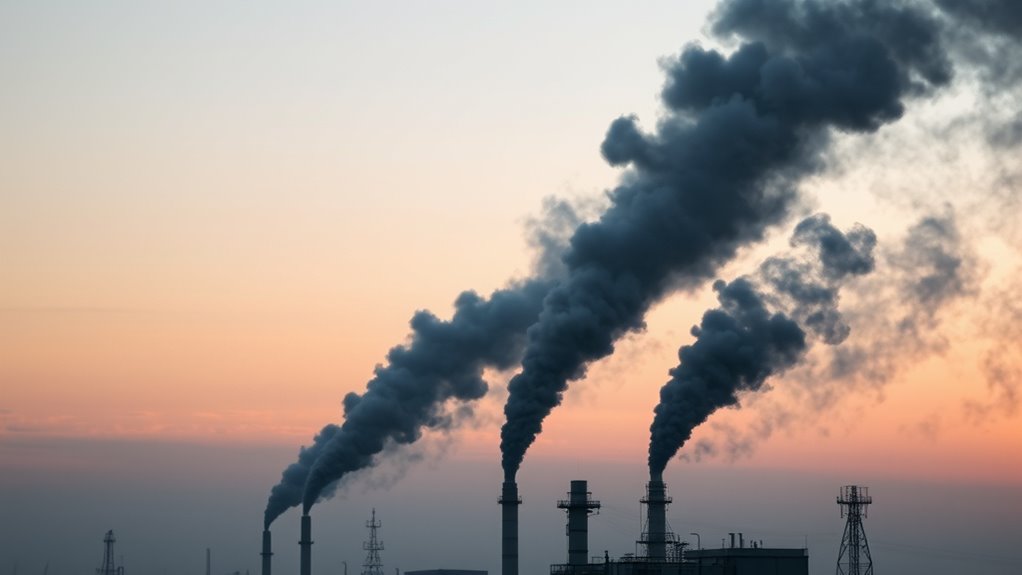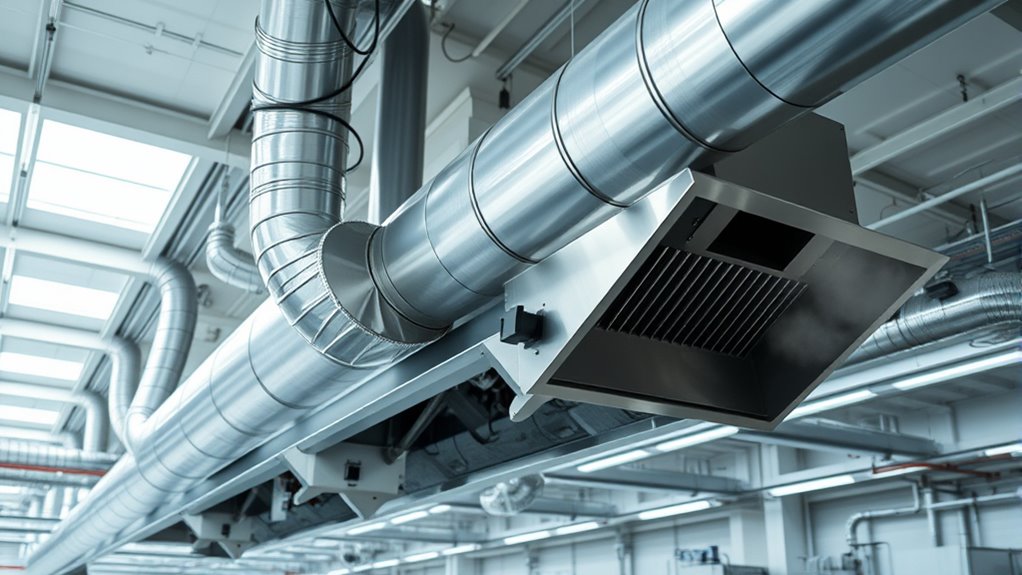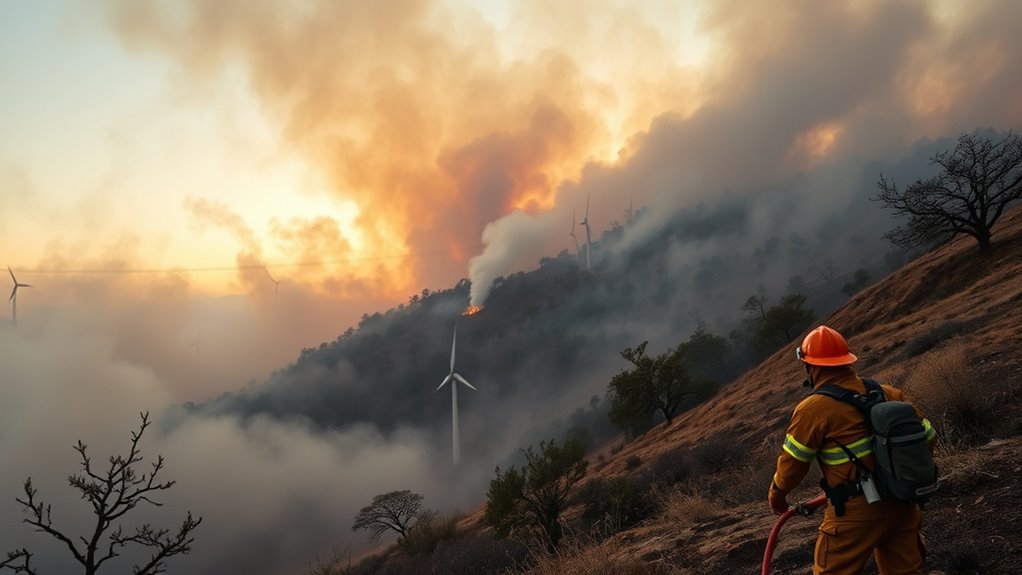The Complete Wind and Smoke Management Playbook guides you through understanding wind dynamics and their impact on smoke dispersion. It emphasizes monitoring strategies, including sensors and modeling tools, to predict and respond to changing conditions. You’ll learn how to design effective ventilation systems, set up physical barriers, and utilize technology for real-time management. Following best practices for emergency response and compliance ensures safety and environmental protection—all vital for controlling smoke spread. Continue exploring to master these essential techniques.
Key Takeaways
- Understand wind dynamics and turbulence to predict smoke dispersion and fire behavior accurately.
- Utilize monitoring tools, sensors, and modeling to assess real-time wind and smoke conditions.
- Implement physical barriers, ventilation layouts, and windbreaks to control smoke spread effectively.
- Leverage automated alerts, predictive modeling, and data integration for rapid response and safety management.
- Ensure regulatory compliance through proper planning, documentation, and community outreach for wildfire mitigation.
Understanding Wind Dynamics and Their Impact

Understanding wind dynamics is essential because wind directly influences how smoke disperses and affects air quality. Wind turbulence causes unpredictable changes in smoke movement, making it harder to forecast its path. When atmospheric pressure differs across regions, it creates pressure gradients that drive wind flow, affecting dispersion patterns. High-pressure systems tend to suppress vertical smoke movement, trapping pollutants near the ground, while low-pressure areas promote upward and lateral dispersion. Wind turbulence intensifies these effects, breaking up smoke plumes and spreading pollutants over wider areas. Recognizing how atmospheric pressure influences wind speed and direction helps you anticipate smoke behavior. Additionally, wind speed variations play a significant role in how quickly and broadly smoke disperses, impacting air quality management. By understanding these core principles, you can better predict smoke dispersal and implement effective management strategies to protect air quality.
Assessing and Monitoring Smoke Dispersion Patterns

Effective assessment and monitoring of smoke dispersion patterns are essential for timely decision-making and protecting air quality. You should regularly observe smoke density to identify high-concentration areas and potential risks. Using dispersion modeling tools allows you to predict how smoke spreads under various wind conditions, helping you anticipate problem zones before they occur. Continuous monitoring with sensors and visual inspections provides real-time data, enabling you to respond swiftly to changing smoke behavior. Combining these approaches ensures a thorough understanding of dispersion patterns, improving your ability to manage smoke effectively. Staying vigilant about smoke density and utilizing dispersion modeling enhances your capacity to minimize health hazards and environmental impact, safeguarding both personnel and surrounding communities. Additionally, understanding smoke dispersion patterns can inform more effective mitigation strategies and emergency responses.
Designing Effective Ventilation and Exhaust Systems

To design effective ventilation and exhaust systems, you need to focus on ideal system layouts that maximize airflow and minimize smoke buildup. Ensuring good exhaust air quality is essential for maintaining a safe environment and preventing harmful concentrations. By carefully planning these components, you can improve overall air movement and protect occupants from smoke hazards. Proper storage conditions for materials like vape juice can also influence the effectiveness of ventilation systems by reducing the release of volatile compounds.
Ventilation System Layouts
Have you ever wondered how to guarantee proper airflow and remove smoke efficiently in a workspace? The key lies in smart ventilation system layouts. Proper fan placement ensures airflow optimization, directing smoke away from work areas effectively. To achieve this, consider the following layout options:
| Layout Type | Pros | Cons |
|---|---|---|
| Linear | Simple, easy to install | Limited coverage |
| Zone-based | Targeted airflow, flexibility | Complex, higher cost |
| Cross-flow | Good for large spaces | May require multiple fans |
Choose a layout that aligns with your workspace size and smoke sources. Proper ventilation design minimizes turbulence and maximizes airflow efficiency, creating a safer, cleaner environment. Unplanned weather changes can also impact ventilation effectiveness, so planning for environmental factors is crucial.
Exhaust Air Quality
Are you confident that your exhaust system is maintaining ideal air quality in your workspace? Proper exhaust air quality relies on effective indoor air filtration that removes pollutants and contaminants efficiently. Regularly evaluate your ventilation and exhaust setup to make sure it minimizes odors and airborne toxins. Implement odor control techniques such as localized exhaust hoods or activated carbon filters to target specific sources of smell. Keep filters clean and replace them as needed to prevent buildup that can compromise air quality. Proper airflow direction and adequate exhaust rates are essential to prevent stale air and ensure fresh air circulates effectively. Ensuring your system incorporates effective ventilation strategies can significantly improve indoor air quality. By prioritizing indoor air filtration and odor control, you create a healthier, more comfortable environment for everyone.
Implementing Strategic Barriers and Windbreaks

Implementing strategic barriers and windbreaks is vital for controlling wind flow and reducing smoke dispersion in affected areas. You should select appropriate barrier materials, such as dense shrubs, fences, or walls, to block or redirect airflow effectively. Windbreak planting involves choosing native trees and plants with dense foliage that can withstand local conditions and provide a natural shield. Proper placement is essential; position barriers upwind of fire-prone zones to funnel or slow the wind, minimizing smoke spread. Combining physical barriers with windbreak planting enhances overall effectiveness. Regular maintenance ensures their longevity and performance. By thoughtfully integrating these strategies, you create a more controlled environment, helping to protect communities and reduce smoke exposure during fire events.
Utilizing Technology for Real-Time Wind and Smoke Management

By harnessing real-time data integration, you can monitor wind and smoke conditions as they change, allowing for quicker responses. Automated alert systems notify you instantly of any dangerous shifts, so you can act promptly. Embracing these technologies keeps you one step ahead in managing fire risks effectively. Incorporating accurate weather forecasting can further enhance your proactive response strategies.
Real-Time Data Integration
Real-time data integration harnesses advanced technology to monitor wind patterns and smoke dispersion continuously, enabling quick and informed decision-making. By integrating live sensor feeds, weather data, and air quality measurements, you can respond swiftly to changing conditions. This approach sharpens your ability to implement source control measures effectively, minimizing smoke impact and protecting air quality. Additionally, understanding AI security vulnerabilities is crucial to safeguarding the integrity of your data streams.
- Use mobile dashboards for instant access to critical data
- Incorporate predictive modeling to anticipate shifts in wind and smoke flow
- Link data streams from multiple sensors for extensive situational awareness
- Enable precise adjustments to ventilation and smoke management strategies
This seamless flow of real-time information empowers you to act proactively, ensuring better environmental outcomes and safer operations.
Automated Alert Systems
Automated alert systems leverage advanced technology to detect changes in wind patterns and smoke dispersion instantly, ensuring you receive timely notifications to act quickly. Proper sensor calibration is essential for accurate readings, so your system reliably identifies shifts that could impact safety. Setting appropriate alert thresholds helps prevent false alarms while ensuring you’re alerted when real risks emerge. These thresholds are customizable, allowing you to tailor alerts based on specific environmental conditions or regulatory standards. When sensors detect deviations beyond set thresholds, the system automatically triggers alerts via SMS, email, or app notifications. This real-time responsiveness enables swift decision-making, minimizing hazards and optimizing response strategies. Incorporating real-time data analysis can further enhance the accuracy and effectiveness of your alerts. By integrating these automated systems into your management plan, you gain a proactive approach to wind and smoke challenges.
Best Practices for Emergency Response and Wildfire Mitigation

Effective emergency response and wildfire mitigation hinge on proactive planning and swift action. You need to develop clear evacuation plans that prioritize safety and facilitate quick, organized exits. Community outreach is essential; educate residents about wildfire risks and preparedness steps well in advance. Regular drills ensure everyone understands their roles during an emergency. Collaborate with local agencies to coordinate resources and response strategies. Establish communication protocols that provide timely updates during crises. Additionally, identify and maintain safe evacuation routes, considering potential obstacles. Invest in training first responders and volunteers to act efficiently under pressure. Building strong relationships within your community encourages collective responsibility and resilience. Regular maintenance of evacuation infrastructure and ensuring proper signage can significantly improve response times and safety during an emergency. These practices ensure you’re better prepared to protect lives and property when wildfire threats arise.
Compliance and Regulatory Considerations

Have you considered how compliance with regulations impacts your wildfire management efforts? Adhering to air quality standards and emission regulations is vital to minimizing wildfire smoke’s impact on communities and ecosystems. Regulations set limits on pollutants released during controlled burns or wildfire suppression activities, ensuring you stay within legal boundaries. Failure to comply can result in fines, project delays, or increased public health risks. It’s essential to understand regional and federal policies regarding smoke emissions and air quality standards. Incorporate proper planning, documentation, and monitoring to demonstrate compliance. Staying informed about evolving regulations helps you adapt your strategies proactively, avoiding penalties and protecting public health. It’s also beneficial to implement vertical storage solutions and organizational strategies to maintain efficient operations during wildfire seasons. Ultimately, regulatory compliance safeguards your operations while promoting responsible wildfire management.
Continuous Improvement and Adaptive Management Strategies

Building on your efforts to comply with regulations, implementing continuous improvement and adaptive management strategies guarantees your wildfire management practices stay effective over time. Regularly conducting wind tunnel testing helps identify how wind patterns influence smoke dispersion and fire behavior, enabling you to refine your approach. Focusing on material durability ensures that equipment and barriers withstand changing environmental conditions, reducing failures. Adaptive strategies involve monitoring real-time data, adjusting tactics promptly, and integrating lessons learned. This iterative process keeps your fire prevention measures resilient.
- Use wind tunnel testing to optimize smoke control systems
- Regularly assess and upgrade materials for durability
- Incorporate feedback loops for timely adjustments
- Stay informed on emerging technologies and research to refine practices
Frequently Asked Questions
How Can Community Engagement Improve Wind and Smoke Management Strategies?
You can improve wind and smoke management strategies through active community engagement by encouraging public participation, which provides valuable local insights and builds trust. Policy collaboration with community members guarantees that strategies are practical and accepted. When residents are involved, they become proactive partners, helping to identify issues early and support effective implementations. This collective effort enhances overall effectiveness and resilience in managing wind and smoke challenges.
What Are Cost-Effective Options for Small-Scale Wind and Smoke Control?
You should consider affordable solutions, DIY techniques, and community-based efforts to control wind and smoke on a small scale. Installing simple barriers like shrubs or fences can redirect airflow and reduce smoke spread. Using natural materials for DIY smoke filters, creating windbreaks from recycled items, and organizing local workshops empower you to implement cost-effective strategies. These approaches are practical, environmentally friendly, and help you actively manage wind and smoke issues without breaking the bank.
How Do Climate Change Trends Affect Future Wind and Smoke Management?
Climate change trends make wind and smoke management more challenging, requiring you to focus on climate adaptation strategies. As weather patterns become more unpredictable, you’ll need to update policies to address stronger winds and increased smoke dispersion. This means investing in flexible, resilient solutions and advocating for policy implications that support proactive management. Staying informed and adaptable guarantees you can effectively respond to changing conditions and protect public health and safety.
Can Natural Landscape Features Be Optimized for Better Wind and Smoke Control?
Yes, you can optimize natural landscape features for better wind and smoke control. Planting vegetation barriers effectively reduces wind speed and directs smoke away from sensitive areas. Additionally, terrain modification, like creating berms or adjusting land contours, helps manage airflow and smoke dispersion. By strategically combining vegetation barriers with terrain adjustments, you enhance natural protection, making your environment safer and more resilient against wind and smoke impacts.
What Training Is Recommended for Personnel Managing Wind and Smoke Issues?
You should undergo thorough hazard assessment training to identify wind and smoke risks effectively. Focus on emergency response skills to act swiftly during incidents, ensuring safety and containment. Learn about atmospheric conditions, wind patterns, and smoke dispersal techniques. Regular drills and updates keep your skills sharp, helping you manage wind and smoke issues proactively. This training ensures you’re prepared to respond efficiently, minimizing hazards and protecting both personnel and the environment.
Conclusion
By understanding wind dynamics, monitoring smoke dispersion, designing effective systems, and implementing strategic barriers, you can protect your environment, guarantee safety, and improve response times. Embrace technology, follow best practices, stay compliant, and commit to continuous improvement. With these strategies, you’re not just managing wind and smoke—you’re mastering them. Take proactive steps, adapt to changing conditions, and turn challenges into opportunities for safer, cleaner, and more resilient environments.









